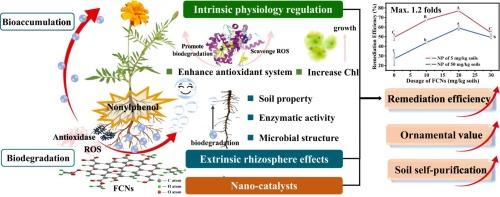纳米催化-植物修复协同策略:功能碳纳米点促进污染土壤中壬基酚的生物降解
IF 11.3
1区 环境科学与生态学
Q1 ENGINEERING, ENVIRONMENTAL
引用次数: 0
摘要
壬基酚污染土壤由于其持久性和生态毒性,其修复仍然具有挑战性。本研究提出了一种将功能性碳纳米点(FCNs)与万寿菊(Tagetes patula L.)相结合的可持续纳米植物修复策略,以有效提高植物修复效率。在5 mg kg - 1和50 mg kg - 1 NP污染的土壤中,20 mg kg - 1的fns比单独的万年青菊(Tagetes patula L.)分别提高了55.9%和118.3%。在两种受NP污染的土壤中,fns -万花菊协同系统对NP的最大修复效率分别达到77.0%和59.0%。本文从纳米催化降解途径、植物生理内源调控和根际微环境外源调控三个维度系统探讨了fcn介导的植物修复增强的协同机制。首先,fcnn通过其独特的化学性质作为纳米催化剂促进NP的氧化分解。其次,fns通过激活np降解途径,缓解np胁迫,提高了万寿菊的耐受性、生物降解效率和观赏价值。其三,fcnn通过上调根际土壤理化性质、酶活性和有益菌群募集,优化根际土壤性质和微环境,提高土壤自净能力。本研究阐明了fcnn和NP在植物-土壤系统中的命运,建立了fcnn -植物修复协同效应,实现了有效的土壤修复。本文章由计算机程序翻译,如有差异,请以英文原文为准。

Nanocatalytic-Phytoremediation Synergistic Strategy: Functional Carbon Nanodots Enhancing Nonylphenol Biodegradation in Contaminated Soil
The remediation of nonylphenol (NP)-contaminated soils remains challenging due to NP’s persistence and ecotoxicity. Here, we present a sustainable nano-phytoremediation strategy that integrates functional carbon nanodots (FCNs) with Tagetes patula L. to effectively enhance phytoremediation efficiency. FCNs at 20 mg kg−1 demonstrated improvements of 55.9% and 118.3% compared to Tagetes patula L. alone in soils contaminated with 5 mg kg−1 and 50 mg kg−1 NP, respectively. The maximum remediation efficiencies for NP in the FCNs-Tagetes patula L. synergistic system reached 77.0% and 59.0% in these two NP-contaminated soils. The synergistic mechanisms underlying FCN-mediated enhancement of phytoremediation were systematically investigated through three dimensions: nano-catalytic degradation pathways, endogenous regulation of plant physiology, and exogenous modulation of rhizosphere microenvironment. First, FCNs functioned as nanocatalysts to facilitate the NP oxidative decomposition via their unique chemical properties. Second, FCNs enhanced the tolerance, biodegradation efficiency, and ornamental value of Tagetes patula L. by activating NP-degradation pathways and alleviating NP-induced stress. Third, FCNs improved soil self-purification capacity by optimizing rhizosphere soil properties and microenvironment through up-regulating physiochemical properties, enzymatic activities, and beneficial microbiome recruitment. This study clarifies the fate of FCNs and NP in plant-soil system and establishes an innovative FCNs-phytoremediation synergy for effective soil remediation.
求助全文
通过发布文献求助,成功后即可免费获取论文全文。
去求助
来源期刊

Journal of Hazardous Materials
工程技术-工程:环境
CiteScore
25.40
自引率
5.90%
发文量
3059
审稿时长
58 days
期刊介绍:
The Journal of Hazardous Materials serves as a global platform for promoting cutting-edge research in the field of Environmental Science and Engineering. Our publication features a wide range of articles, including full-length research papers, review articles, and perspectives, with the aim of enhancing our understanding of the dangers and risks associated with various materials concerning public health and the environment. It is important to note that the term "environmental contaminants" refers specifically to substances that pose hazardous effects through contamination, while excluding those that do not have such impacts on the environment or human health. Moreover, we emphasize the distinction between wastes and hazardous materials in order to provide further clarity on the scope of the journal. We have a keen interest in exploring specific compounds and microbial agents that have adverse effects on the environment.
 求助内容:
求助内容: 应助结果提醒方式:
应助结果提醒方式:


